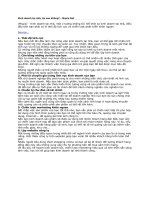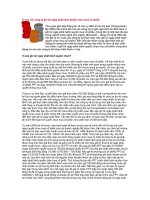Distributional Weighting docx
Bạn đang xem bản rút gọn của tài liệu. Xem và tải ngay bản đầy đủ của tài liệu tại đây (251.74 KB, 34 trang )
© Harry Campbell & Richard Brown
School of Economics
The University of Queensland
BENEFIT-COST ANALYSIS
BENEFIT-COST ANALYSIS
Financial and Economic
Financial and Economic
Appraisal using Spreadsheets
Appraisal using Spreadsheets
Ch. 11: Distributional Weighting
Accounting for Income Distribution
In the preceding chapters we assumed that
each $ of net benefits of same value irrespective
of sub-referent group
We need to acknowledge and account for:
Government’s income distribution objectives
project’s distributional impacts
Accounting for Income Distribution
Atemporal – how income (and income
changes) distributed among individuals or
groups at present; ie. within present generation
Atemporal vs. Intertemporal Distribution
Intertemporal – how income (and income
changes) distributed over time; ie. between
present and future generations
Accounting for Income Distribution
How income is distributed among individuals
or households
Interpersonal distribution
See Tables 11.1 and 11.2
Table 11.1 Distribution of Households by Annual Income
Annual Income (
Y
= $189)
% Households
Less than $100
$100 to 200
$200 to 300
$300 to 400
$400 to 500
More than $500
30.7
42.9
13.4
5.8
2.7
4.5
Accounting for Income Distribution
Measuring Interpersonal distribution
Accounting for Income Distribution
Measuring Interpersonal distribution
Table 11.2 Income Distribution by Deciles
Households
% of Income
Top 1 per cent
Top 2 per cent
Top 10 per cent
2nd decile
3rd decile
4th decile
5th decile
6th decile
7th decile
8th decile
9th decile
Bottom decile
8.31
22.81
33.73
15.49
11.61
9.22
8.12
7.32
6.47
2.94
2.67
2.45
Accounting for Income Distribution
Measuring Inequality
Income is obviously not equally
distributed – some individuals or groups
earn more than others
The degree of income inequality can vary
considerably between countries and, within
a country, over time.
Economists have devised ways of
measuring degree of inequality
Accounting for Income Distribution
Measuring Inequality
Figure 11.1 The Lorenz Curve
Cumulative %
population
Cumulative % income
0
0
100
100
If income was
equally
distributed the
Lorenz curve
would lie on
the diagonal
The flatter the L-
curve, the smaller
the shaded area,
the less the degree
of inequality
GINI
Coefficient =
shaded area
as a % of
whole triangle
0.8
0.2
Cumulative % pop
Cumulative % income
Measure
area
outside
the main
triangle
Each triangle
= 0.8x0.2)/2
= 0.08
Square =
0.2x0.2
=0.04
Total
=(0.08x2)+0.04
=0.2
Gini coeff.
= (0.5-0.2)/0.5
= 0.3/0.5 = 0.6
Measuring Inequality
Assume 20% population earns 80% of income
government can affect the distribution of income
between sectors and regions of the economy through
the sectoral and regional spread of public investment
projects
the type of investment undertaken can influence the
distribution of income among various categories of
income-earners
an investment that uses relatively more labour than
capital will imply more employment, and perhaps, a
larger share of income for the wage-earner versus the
profit-earner, and vice versa
different types of investment will have different
implications for the employment (and income) of
different types of labour
Changing Income Distribution
While one investment option could be superior to another from
an economic efficiency viewpoint, it might be inferior to the other
from a distributional perspective
The final choice among projects will depend on the relative
importance that the policy-makers attach to the economic
efficiency objective versus the income distribution objective.
It is to the explicit incorporation of distributional objectives in
benefit-cost analysis that we now turn.
Changing Income Distribution
Suppose that we are required to advise on the best choice of
projects taking into consideration the government's commitment to
the twin objectives of economic efficiency and improving income
distribution
In Table 11.5 we have before us 3 possible projects, A, B and C,
of which only one can be undertaken.
Each project affects income distribution differently
How can we incorporate government’s income distribution
objective into project choice explicitly?
Distributional Weighting
Distributional Weighting
Table 11.5 Comparing projects with different atemporal distributions
Referent Group Net Benefits ($NPV)
Project
Rich
Poor
Total
A
B
C
60
50
20
40
30
80
100
80
100
Project B can be rejected purely on economic efficiency
grounds - its aggregate net referent group benefits are less than
those of A and B, and the distribution of benefits among the rich
and poor is less egalitarian than that of either A or C.
the question is whether to choose A or C?
Distributional Weighting
Project D would be preferred on purely economic efficiency
grounds, whereas Project E might be preferred on purely
distribution grounds.
As long as there is a commitment to the objectives of
economic efficiency and income distribution, a conflict arises.
Choose D and we sacrifice distribution; choose E and we
sacrifice efficiency.
Table 11.6 Comparing projects with different aggregate benefits and distributions
Referent Group Net Benefits ($NPV)
Project
Rich
Poor
Total
D
E
60
40
40
50
100
90
What about choosing between D and E?
This choice is a classic example of what
economists call a trade-off.
assume we weight each additional dollar of net
benefit received by the poor by three times as much
as each additional dollar received by the rich
Distributional Weighting
Table 11.7 Applying distributional weights to project net benefits
Referent Group Net Benefits
($NPV)
Weighted (Social) Benefits
($)
Project
Rich
Poor
Total
Rich
Poor
Total
D
E
60
40
40
50
100
90
(60x1.0)+(40x3.0) = 180
(40x1.0)+(50x3.0) = 190
If the government did not attach different
distributional weights to the net benefits accruing
to different groups, projects would be selected
purely on the basis of their aggregate referent
group net benefits.
What would this imply about the government's
objective concerning income redistribution?
From what we have seen, it could mean one of
two things: either
(a) it does not regard project selection as an
important means of redistributing income; or,
(b) it does not care about income distribution; i.e. it
attaches equal weight (1.0) to all sub-referent
group members.
Distributional Weighting
Deriving Distributional Weights
Theoretical Basis
Diminishing marginal utility of consumption
Figure 11.2 Total Utility Curve
3
2
1
12
23
32
Consumption level (units)
Utility
Deriving Distributional Weights
Theoretical Basis
Diminishing marginal utility of consumption
Figure 11.3 Marginal Utility Curve
12
3
2
1
9
11
Consumption level (units)
Marginal
Utility
d
i
= the distribution weight for income group I
Y bar = the average level of income for the economy
Y
i
= the average income level of group I
n = the elasticity (responsiveness) of marginal utility
with respect to an increase in income, expressed as the ratio
of the percentage fall in marginal utility to the percentage rise
in income
)
Y
Y
( =
d
n
1
i
Deriving Distributional Weights
The appropriate income distribution weight can be
expressed in algebraic form as follows:
= 2
n
Deriving Distributional Weights
As an example of the use of such weights, suppose that a
net beneficiary of a project is in an income group which has
a level of income equal to, say, $750 per annum (Y
i
), and
that the national average income is $1500 (); the distribution
weight for that individual would then be:
)
750
1500
( =
d
n
i
If n = 0.8, then an individual at consumption level
$750 per annum will have her benefits weighted by a
factor of 1.74
Deriving Distributional Weights
Someone at an income level of $2500 per annum will have
his/her benefits weighted by a factor of 0.66
An additional $1.00 going, for example, to someone
earning an income of $4250 per annum would be
valued at only 43% of the value of an additional $1.00
going to someone at the average ($1500 per annum)
income level.
Deriving Distributional Weights
Figure 11.4 Weighting Factors for Extra Income
Income level ($)
Weight
0.43
0.66
1.00
1.74
750
1550
2250
4250
Deriving Distributional Weights
The higher the value of n, the faster the rate at which
marginal utility falls.
Table 11.8 Responsiveness of distributional weights to changes in n
Distributional Weight
d
i
$/Annum
n = 0
n = 1
n = 2
n = 3
250
750
1250
1500
1750
2250
2750
3250
3750
4250
1.00
1.00
1.00
1.00
1.00
1.00
1.00
1.00
1.00
1.00
6.00
2.00
1.20
1.00
0.71
0.67
0.55
0.46
0.40
0.35
36.00
4.00
1.44
1.00
0.73
0.44
0.30
0.21
0.16
0.12
216.00
8.00
1.73
1.00
0.63
0.30
0.16
0.10
0.06
0.04
Deriving Distributional Weights
The formula for d
i
expresses the point that the distributional
weights we use are determined by two factors:
(a) the relative income/consumption level of the project
beneficiaries ; and,
(b) the value-judgement that is made about the utility or
satisfaction that is gained by project beneficiaries of different
income levels; the value of n.
If we do not apply distributional weights explicitly, we are
implicitly assigning a value d
i
= 1.00 to each and every project
beneficiary, irrespective of how much (s)he earns
In some circumstances we can infer from the choices the
decision-maker makes what (s)he regards as the appropriate
or “threshold” distributional weights, but, it does not provide
any independent information about the appropriate weights.
Using Distributional Weights
To apply distributional weights we would need to know the
following about the project in question:
(a) identification of the project's gainers and losers;
(b) classification of the project's gainers and losers; i.e. to
which particular income category they belong; and,
(c) quantification of gains and losses, i.e. by how much do
the net incomes of the gainers and losers increase or
decrease?
The relevant project level information about (a) and (c)
already exists, for this is, in effect, what is contained in the
Referent Group analysis








